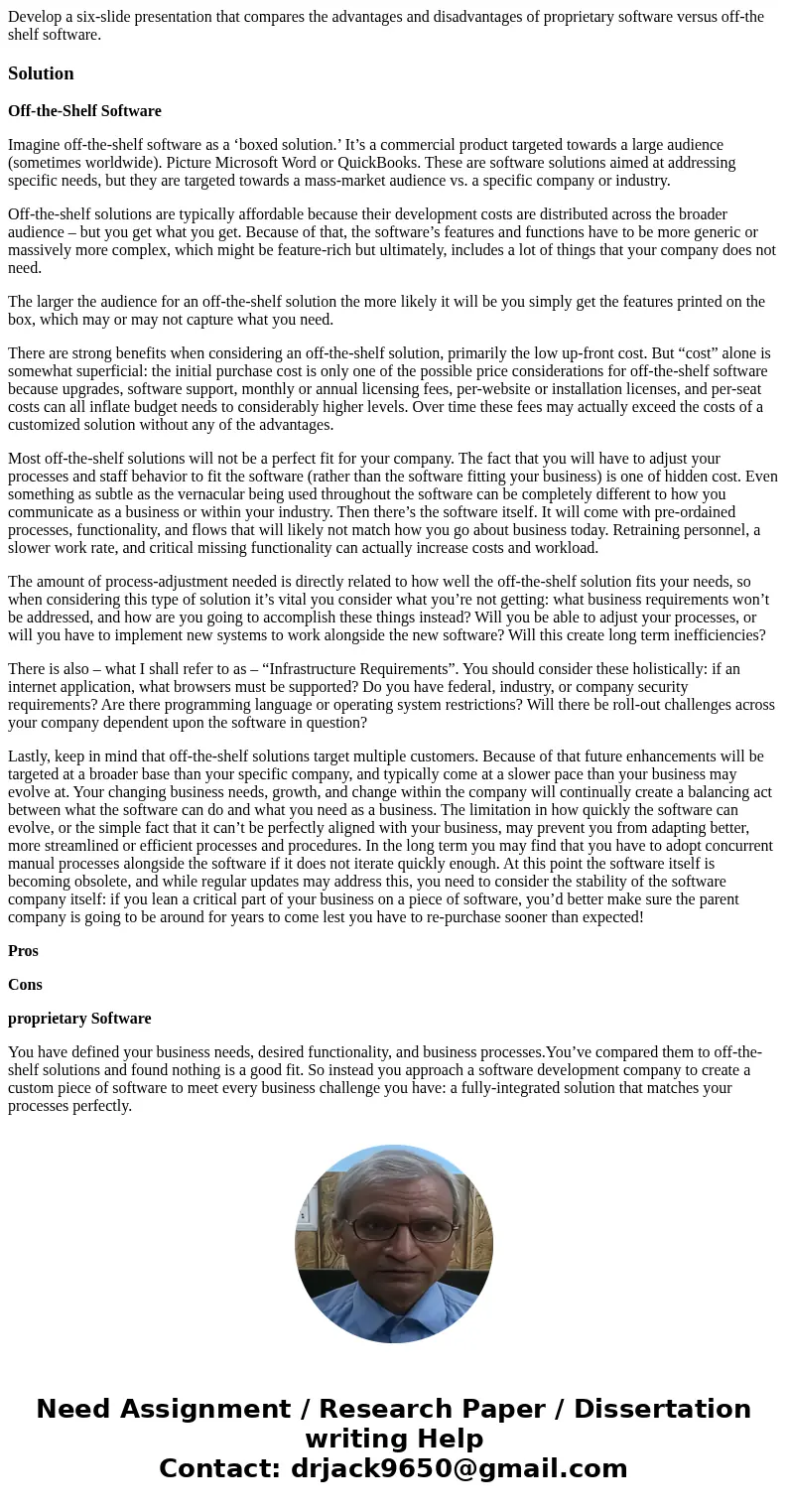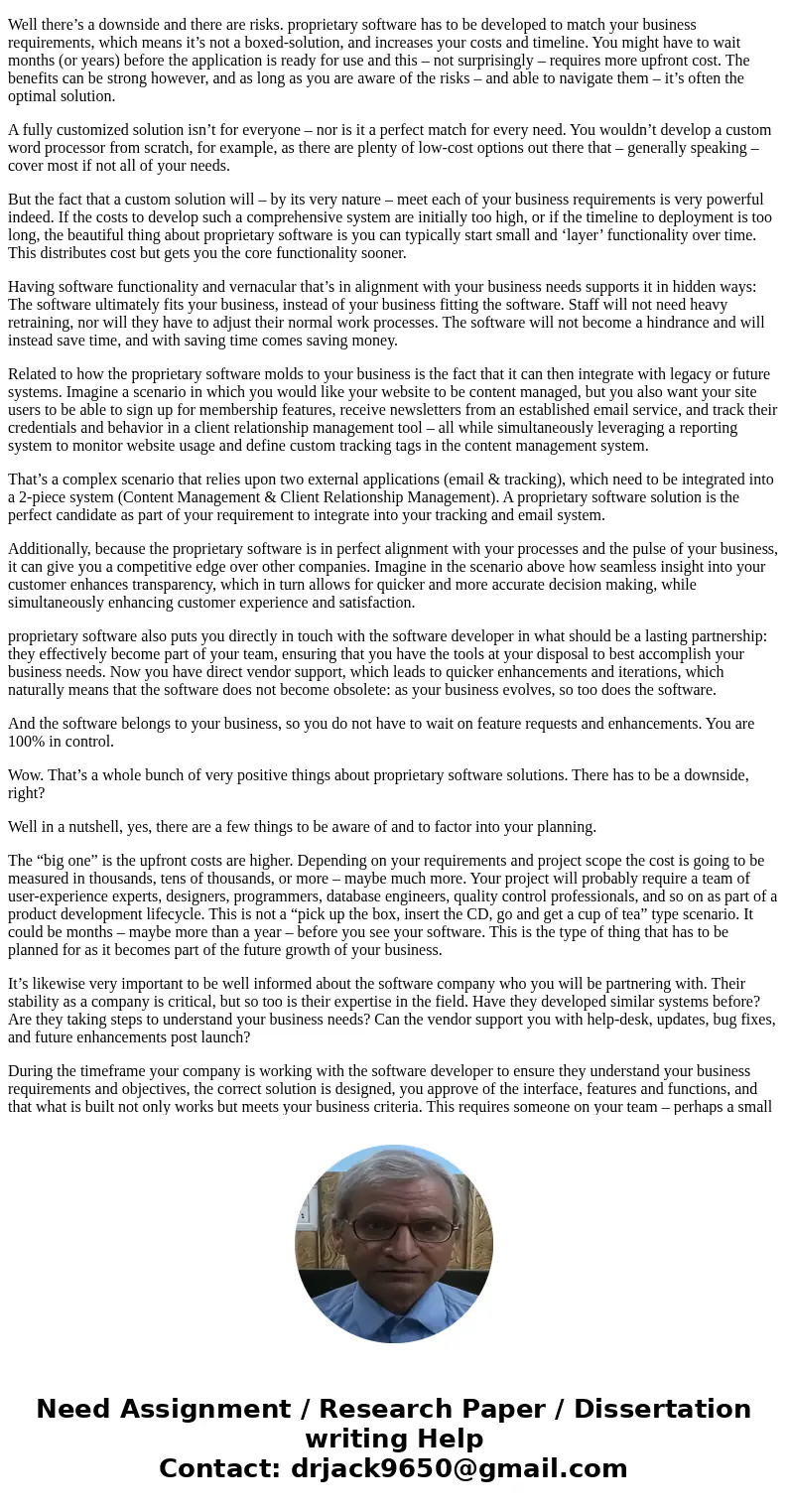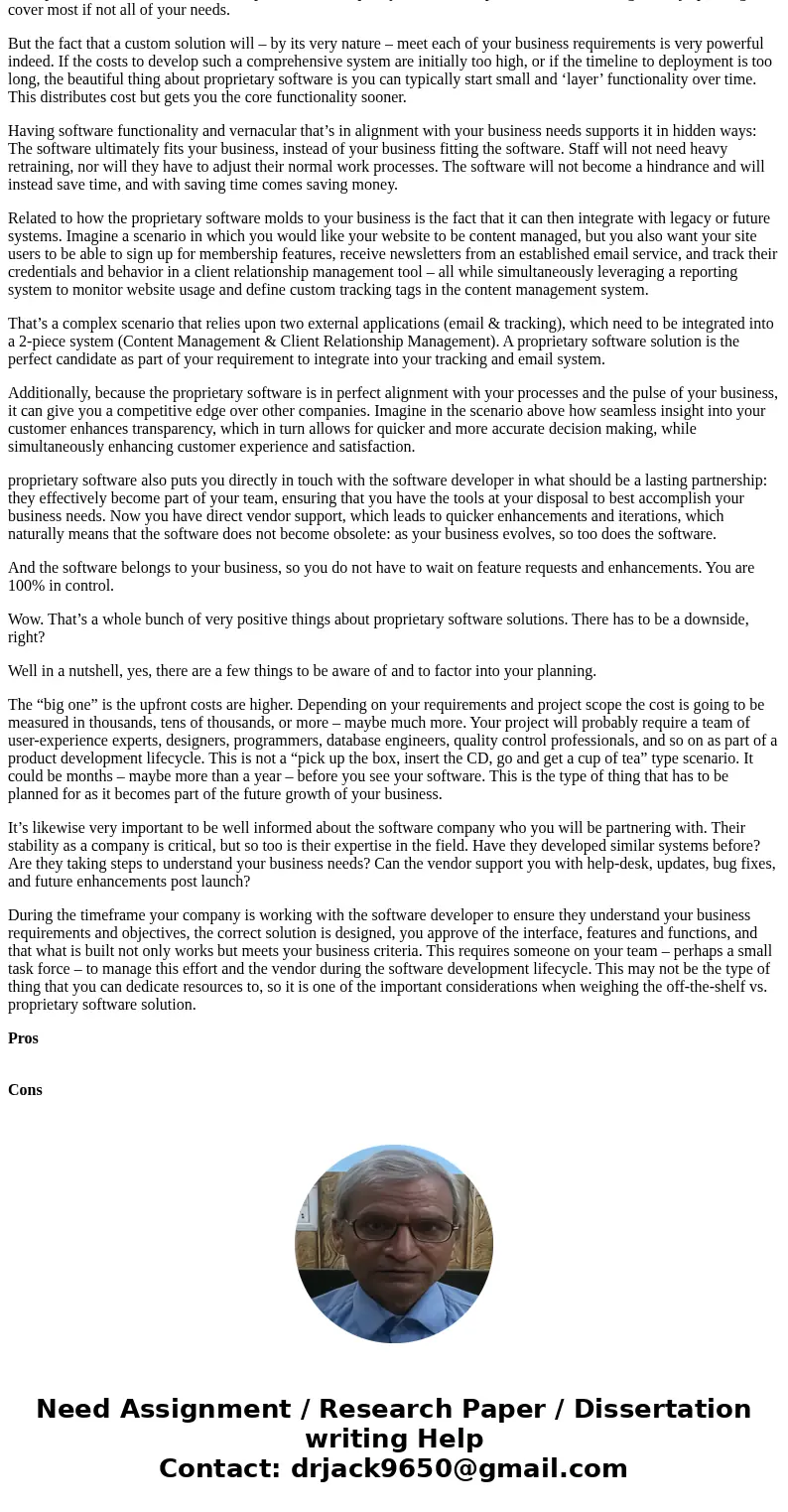Develop a sixslide presentation that compares the advantages
Develop a six-slide presentation that compares the advantages and disadvantages of proprietary software versus off-the shelf software.
Solution
Off-the-Shelf Software
Imagine off-the-shelf software as a ‘boxed solution.’ It’s a commercial product targeted towards a large audience (sometimes worldwide). Picture Microsoft Word or QuickBooks. These are software solutions aimed at addressing specific needs, but they are targeted towards a mass-market audience vs. a specific company or industry.
Off-the-shelf solutions are typically affordable because their development costs are distributed across the broader audience – but you get what you get. Because of that, the software’s features and functions have to be more generic or massively more complex, which might be feature-rich but ultimately, includes a lot of things that your company does not need.
The larger the audience for an off-the-shelf solution the more likely it will be you simply get the features printed on the box, which may or may not capture what you need.
There are strong benefits when considering an off-the-shelf solution, primarily the low up-front cost. But “cost” alone is somewhat superficial: the initial purchase cost is only one of the possible price considerations for off-the-shelf software because upgrades, software support, monthly or annual licensing fees, per-website or installation licenses, and per-seat costs can all inflate budget needs to considerably higher levels. Over time these fees may actually exceed the costs of a customized solution without any of the advantages.
Most off-the-shelf solutions will not be a perfect fit for your company. The fact that you will have to adjust your processes and staff behavior to fit the software (rather than the software fitting your business) is one of hidden cost. Even something as subtle as the vernacular being used throughout the software can be completely different to how you communicate as a business or within your industry. Then there’s the software itself. It will come with pre-ordained processes, functionality, and flows that will likely not match how you go about business today. Retraining personnel, a slower work rate, and critical missing functionality can actually increase costs and workload.
The amount of process-adjustment needed is directly related to how well the off-the-shelf solution fits your needs, so when considering this type of solution it’s vital you consider what you’re not getting: what business requirements won’t be addressed, and how are you going to accomplish these things instead? Will you be able to adjust your processes, or will you have to implement new systems to work alongside the new software? Will this create long term inefficiencies?
There is also – what I shall refer to as – “Infrastructure Requirements”. You should consider these holistically: if an internet application, what browsers must be supported? Do you have federal, industry, or company security requirements? Are there programming language or operating system restrictions? Will there be roll-out challenges across your company dependent upon the software in question?
Lastly, keep in mind that off-the-shelf solutions target multiple customers. Because of that future enhancements will be targeted at a broader base than your specific company, and typically come at a slower pace than your business may evolve at. Your changing business needs, growth, and change within the company will continually create a balancing act between what the software can do and what you need as a business. The limitation in how quickly the software can evolve, or the simple fact that it can’t be perfectly aligned with your business, may prevent you from adapting better, more streamlined or efficient processes and procedures. In the long term you may find that you have to adopt concurrent manual processes alongside the software if it does not iterate quickly enough. At this point the software itself is becoming obsolete, and while regular updates may address this, you need to consider the stability of the software company itself: if you lean a critical part of your business on a piece of software, you’d better make sure the parent company is going to be around for years to come lest you have to re-purchase sooner than expected!
Pros
Cons
proprietary Software
You have defined your business needs, desired functionality, and business processes.You’ve compared them to off-the-shelf solutions and found nothing is a good fit. So instead you approach a software development company to create a custom piece of software to meet every business challenge you have: a fully-integrated solution that matches your processes perfectly.
Well there’s a downside and there are risks. proprietary software has to be developed to match your business requirements, which means it’s not a boxed-solution, and increases your costs and timeline. You might have to wait months (or years) before the application is ready for use and this – not surprisingly – requires more upfront cost. The benefits can be strong however, and as long as you are aware of the risks – and able to navigate them – it’s often the optimal solution.
A fully customized solution isn’t for everyone – nor is it a perfect match for every need. You wouldn’t develop a custom word processor from scratch, for example, as there are plenty of low-cost options out there that – generally speaking – cover most if not all of your needs.
But the fact that a custom solution will – by its very nature – meet each of your business requirements is very powerful indeed. If the costs to develop such a comprehensive system are initially too high, or if the timeline to deployment is too long, the beautiful thing about proprietary software is you can typically start small and ‘layer’ functionality over time. This distributes cost but gets you the core functionality sooner.
Having software functionality and vernacular that’s in alignment with your business needs supports it in hidden ways: The software ultimately fits your business, instead of your business fitting the software. Staff will not need heavy retraining, nor will they have to adjust their normal work processes. The software will not become a hindrance and will instead save time, and with saving time comes saving money.
Related to how the proprietary software molds to your business is the fact that it can then integrate with legacy or future systems. Imagine a scenario in which you would like your website to be content managed, but you also want your site users to be able to sign up for membership features, receive newsletters from an established email service, and track their credentials and behavior in a client relationship management tool – all while simultaneously leveraging a reporting system to monitor website usage and define custom tracking tags in the content management system.
That’s a complex scenario that relies upon two external applications (email & tracking), which need to be integrated into a 2-piece system (Content Management & Client Relationship Management). A proprietary software solution is the perfect candidate as part of your requirement to integrate into your tracking and email system.
Additionally, because the proprietary software is in perfect alignment with your processes and the pulse of your business, it can give you a competitive edge over other companies. Imagine in the scenario above how seamless insight into your customer enhances transparency, which in turn allows for quicker and more accurate decision making, while simultaneously enhancing customer experience and satisfaction.
proprietary software also puts you directly in touch with the software developer in what should be a lasting partnership: they effectively become part of your team, ensuring that you have the tools at your disposal to best accomplish your business needs. Now you have direct vendor support, which leads to quicker enhancements and iterations, which naturally means that the software does not become obsolete: as your business evolves, so too does the software.
And the software belongs to your business, so you do not have to wait on feature requests and enhancements. You are 100% in control.
Wow. That’s a whole bunch of very positive things about proprietary software solutions. There has to be a downside, right?
Well in a nutshell, yes, there are a few things to be aware of and to factor into your planning.
The “big one” is the upfront costs are higher. Depending on your requirements and project scope the cost is going to be measured in thousands, tens of thousands, or more – maybe much more. Your project will probably require a team of user-experience experts, designers, programmers, database engineers, quality control professionals, and so on as part of a product development lifecycle. This is not a “pick up the box, insert the CD, go and get a cup of tea” type scenario. It could be months – maybe more than a year – before you see your software. This is the type of thing that has to be planned for as it becomes part of the future growth of your business.
It’s likewise very important to be well informed about the software company who you will be partnering with. Their stability as a company is critical, but so too is their expertise in the field. Have they developed similar systems before? Are they taking steps to understand your business needs? Can the vendor support you with help-desk, updates, bug fixes, and future enhancements post launch?
During the timeframe your company is working with the software developer to ensure they understand your business requirements and objectives, the correct solution is designed, you approve of the interface, features and functions, and that what is built not only works but meets your business criteria. This requires someone on your team – perhaps a small task force – to manage this effort and the vendor during the software development lifecycle. This may not be the type of thing that you can dedicate resources to, so it is one of the important considerations when weighing the off-the-shelf vs. proprietary software solution.
Pros
Cons



 Homework Sourse
Homework Sourse